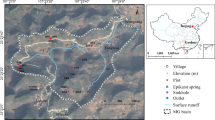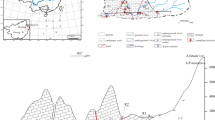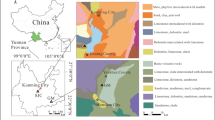Abstract
As an intuitive way, the method of limestone tablets (MLT) is often used in dissolution rate calculation and carbon cycle research of carbonate rocks. To clarify the influential factors and spatial suitability of MLT in karst carbon cycle study, 30 MLT test sites in China from north to south were collected and the tablets’ dissolution rate (TDR) was analyzed. The results showed that the influence of precipitation on the TDR is more significant than that of the temperature, especially in the impact on the underground tablets. Three typical river basins, i.e., the Nanchuan River karst basin of northern China (NKB), Qingliangsigou loess basin of northern China (QLB), and Wujiang River karst basin of southern China (WKB) were collected as the key research areas to reveal the regional factors of lithology, soil physical–chemical properties, and land use that affect TDR. The results show that the higher the acid insolubility of rocks, the lower is the dissolution rate. Soil CO2 displayed a positive correlation with TDR in both the northern and southern karst areas of China. Because soil inorganic carbon (SIC) always causes carbon deposits on the tablet surface which made the calculated results of carbon sink inaccurate, the MLT is not suitable for carbon cycle research in the loess area where high SIC is contained. The hydrochemical runoff method may be better selected. In the arid and semi-arid karst basin of northwestern and northern China, the high SIC area should be avoided during carbon sink study with MLT.
Graphic abstract












Similar content being viewed by others
References
Cao J, Yuan D, Groves C, Huang F, Yang H, Lu Q (2012) Carbon fluxes and sinks: the consumption of atmospheric and soil CO2 by carbonate rock dissolution. Acta Geol Sin Engl 86(4):963–972
Corbel J (1959) Erosion en terrain calcaire. Ann Geogr 68:97–120
Covington MD, Vaughn KA (2019) Carbon dioxide and dissolution rate dynamics within a karst underflow-overflow system, Savoy Experimental Watershed, Arkansas, USA. Chem Geol 527:0009–2541
De Waele J, Plan L, Audra P (2009) Recent developments in surface and subsurface karst geomorphology: an introduction. Geomorphology 106(1–2):1–8
Ellaway M, Smith DI, Gillieson DS (1990) Karst water chemistry-limestone ranges, western Australia. Helictite 28:5–36
Furlani S, Cucchi F, Forti F, Rossi A (2009) Comparison between coastal and inland Karst limestone lowering rates in the northeastern Adriatic Region (Italy and Croatia). Geomorphology 104:73–81
Gams I (1981) Comparative research of limestone solution by means of standard tablets. In: Proceedings of the 8th international congress of speleology bowling green, vol 1. Kentucky, pp 273–275
Gams I (1986) International comparative measurements of surface solution by means of standard limestone tablets. In: Zbornik Ivana Rakovca. SAZU, Ljubljana, pp 361–386
Han G, Liu C (2004) Water geochemistry controlled by carbonate dissolution: a study of the river waters draining karst-dominated terrain, Guizhou Province, China. Chem Geol 204:1–21
High C, Hanna GK (1970) A method for the direct measurement of erosion of rock surfaces. Br Geomorphol Res Group Tech Bull 5:1–24
Huang Q, Qin X, Liu P, Kang Z, Tang P (2015) Applicability of karst carbon sinks calculation methods in semi-arid climate environment. J Jilin Univ Earth Sci Ed 45(1):240–246 (in Chinese)
Huang Q, Qin X, Liu P, Zhang L, Su C (2016) The impact of human activities to δ13CDIC of karst groundwater and carbon sink in the upper and middle reaches of Wujiang river. Quat Sci 36(6):1358–1369 (in Chinese)
Jin Z, Dong Y, Wang Y, Wei X, Wang Y, Cui B, Zhou W (2014) Natural vegetation restoration is more beneficial to soil surface organic and inorganic carbon sequestration than tree plantation on the Loess Plateau of China. Sci Total Environ 485:615–623
Li Q, He Y, Li Z (2017) The promoting effect of soil carbonic anhydrase on the limestone dissolution rate in SW China. Carbonates Evaporites 32(2):147–154
Li S, Liu C, Li J, Lang Y, Ding H, Li L (2010) Geochemistry of dissolved inorganic carbon and carbonate weathering in a small typical karstic catchment of Southwest China: isotopic and chemical constraints[J]. Chem Geol 277(3–4):301–309
Liang Y, Wang W, Duan G (2007) Discussion on the result of field corrosion test around Erdos Basin. Carsologica Sin 4:315–320 (in Chinese)
Liu Z (2011) “Method of maximum potential dissolution” to calculate the intensity of karst process and the relevant carbon sink: with discussions on methods of solute load and carbonate-rock-tablet test. Carsologica Sin 30(4):379–382 (in Chinese)
Luo M, Zhou H, Liang Y, Chen Z, Chen R, Lin X, Jakada H (2018) Horizontal and vertical zoning of carbonate dissolution in China. Geomorphology 322:66–75
Nordt LC, Wilding LP, Drees LR (2000) Pedogenic carbonate transformations in leaching soil system: implication for the global C cycle. In: Lal R, Kimble JM, Eswaran H, Stewart BA (eds) Global climate change and pedogenic carbonates. CRC Press, Boca Raton
Plan L (2005) Factors controlling carbonate dissolution rates quantified in a field test in the Austrian alps. Geomorphology 68(3–4):201–212
Ren M, Liu Z (1983) Introduction to karstology. Commercial Press, Beijing (in Chinese)
Renforth P, Manning D, Lopez-Capel E (2009) Carbonate precipitation in artificial soils as a sink for atmospheric carbon dioxide. Appl Geochem 24(9):1757–1764
Sartori F, Lal R, Ebinger MH, Eaton JA (2007) Changes in soil carbon and nutrient pools along a chronosequence of poplar plantations in the Columbia Plateau, Oregon, USA. Agric Ecosyst Environ 122:325–339
Shao M, Zhang L, Liu P, Shao T, Cao J, Qin X, Zhang C (2019) Mineral dissolution and carbon sink effect in a typical small watershed of the Loess area. Earth Environ 47(5):575–585 (in Chinese)
Stone J, Evans J, Fifield L, Allan G, Cresswell R (1998) Cosmogenic chlorine-36 production in calcite by muons. Geochim Cosmochim Acta 62:433–454
Trudgill ST (1975) Measurements of erosional weight loss of rock tablets. Br Geomorphol Res Group Tech Bull 17:13–19
Trudgill S, High CJ, Hanna FK (1981) Improvement to the micro-erosion meter. Br Geomorphol Res Group Tech Bull 29:3–17
Wan G, Wang S (2000) Effects of the atmospheric CO2 in karst area of southern and loess area of northern China. Quat Sci 20(4):305–315 (in Chinese)
Yang S, Ding Z (2017) Spatial changes in grain size of loess deposits in the Chinese loess plateau and implications for palaeoenvironment. Quat Sci 37(5):934–944 (in Chinese)
Yuan D (1993) China karstology. Geology Press, Beijing, pp 1–30 (in Chinese)
Zhang C (2011) Carbonate rock dissolution rates in different land uses and their carbon sink effect. Chin Sci Bull 56(35):3759–3765
Acknowledgements
This research was funded by the National Natural Science Foundation of China (41671213), the Geological Survey Project of China Geological Survey (DD20190502, DD20160305), and the Shandong Provincial Geological Exploration Project (Lukanzi [2016] No. 79).
Author information
Authors and Affiliations
Corresponding authors
Additional information
Publisher's Note
Springer Nature remains neutral with regard to jurisdictional claims in published maps and institutional affiliations.
Rights and permissions
About this article
Cite this article
Shao, M., Zhang, L., Liu, P. et al. Influential factors and spatial suitability of the method of limestone tablets in karst carbon cycle study in China. Carbonates Evaporites 35, 85 (2020). https://doi.org/10.1007/s13146-020-00613-5
Accepted:
Published:
DOI: https://doi.org/10.1007/s13146-020-00613-5




